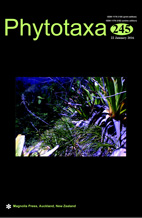Abstract
Smilax biflora is an insular species which only occurs on two islands of the northern Ryukyus, Japan. It is also the smallest species of the genus, probably due to the adaptation to the special insular understory environment. Morphological, karyotype and molecular data indicate that the two known populations of S. biflora (bWJ, Yakushima, 2n = 32 and bAM, Amami, 2n = 60) have undergone parallel evolution, with the Yakushima population nested within S. trinervula (2n = 32) and the Amami population sister to them. The two populations of S. biflora also show statistically significant difference in leaf morphology, although they seem to present similar morphological characters of dwarf habit, flexuose stems, dense thorns and small leaves. Thus we recognize the Amami population as a new species, Smilax amamiana Z.S.Sun & P.Li. The discovery of the unique nature of S. biflora highlights the importance of closer examinations on insular species by integrating multiple lines of evidence.

